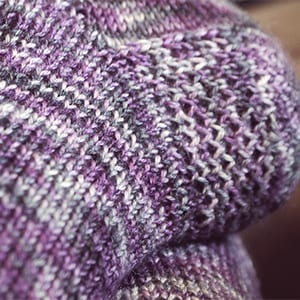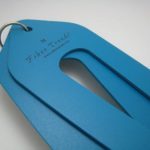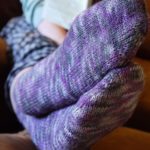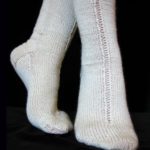Top-Down, Two-at-a-Time Socks
Table of Contents
Fingering-Weight Top-Down Socks
- Pattern Overview/Walkthrough of Finished Project
- Pattern: Fingering-Weight Top-Down Socks for Magic Loop
Casting On For Top-Down, Two-at-a-Time Socks
- Liat’s Limitless Cast-On for Two-at-a-Time Anything
- Optional: Simple 3-Stitch Lace Pattern for Socks
- Avoiding Gaps in Two-at-a-Time Socks
- Illustration: Knitting Two-at-a-Time
Fixing Mistakes on Two-at-a-Time Socks
Creating and Turning a Top-Down Heel
- How to Knit a Heel Flap
- How to Turn a Top-Down Heel
- How to Pick Up Stitches Along the Sides of the Heel Flap
- How to Work the Heels on Two-at-a-Time Socks
- How to Purl Backwards for Fast-Turn Heels
Foot
Finishing
Top-Down Socks – Extras
- Top-Down Sock Patterns In Other Weights
- Adding Creative Stitches To a Basic Top-Down Sock Pattern
- Illustrated Guide to Kitchener Stitch
Heel Stitch-Pattern Videos
Top-Down, Two-at-a-Time Socks
Why learn two-at-a-time socks top-down, especially if you can already knit them toe-up?
Because the top-down method has many important techniques that you must master if you are going to be a Knitting Superstar.
Skills You Will Learn Doing Top-Down Socks
 Most importantly, you will learn to cast on for and knit two tubes at a time that aren’t closed off on the end. This cast-on also works for knitting mittens, gloves, and sweater sleeves two at a time.
Most importantly, you will learn to cast on for and knit two tubes at a time that aren’t closed off on the end. This cast-on also works for knitting mittens, gloves, and sweater sleeves two at a time.
Also, many sock patterns are written from the top down, and learning how to do them will broaden your possibilities even more.
Knowing how to create a heel flap and pick up stitches correctly will help you whenever you are making a sweater.
We’ll also be covering Kitchener stitch, the invisible way to bind off two sides of a project together.
About This Project: Fingering-Weight Top-Down Socks
 The construction of this top-down sock has a heel that fits perfectly and snugly. Also, since socks are sort of modular (you can substitute any kind of heel, toe, or cuff that you like), it behooves you to learn do to more than one kind of heel.
The construction of this top-down sock has a heel that fits perfectly and snugly. Also, since socks are sort of modular (you can substitute any kind of heel, toe, or cuff that you like), it behooves you to learn do to more than one kind of heel.
This project will give you the chance to knit on small needles and get used to how they feel, as well as trying out some of the gorgeous and fun sock yarns out there today.
Two-at-a-Time… For the First Time?
You don’t have to knit both socks at the same time if you aren’t ready. To knit one sock at a time, just cast on for one sock and follow the directions, ignoring any mention of the other sock.
If you are only a little nervous, however, let me encourage you to try the two-at-a-time method. It’s not much harder than one-at-a-time, and I’ll be with you every step of the way.
How To Use This Course
Just like cooking a meal with a recipe you’ve never used before, I highly recommend that you scan all the way through this tutorial, or at least read a section ahead before beginning.
The reason I’m asking you to do this is that some of the techniques have more than one video, and I give instructions followed by troubleshooting videos. I’d hate for you to miss seeing a video that would’ve helped you. Ready? Let’s get started.
Project: Top-Down Socks, Two-at-a-Time
For your top-down socks, we are going to make a pair of fingering-weight socks for adults. Let’s go to the yarn shop.
Download the Fingering-Weight Top-Down Socks for Magic Loop pattern here
Choose Your Materials
Yarn: You’ll need two skeins of fingering (sock) weight wool – about 150 yards for a pair of crew- length socks.
I recommend that you choose a machine-washable yarn in a light color (so you can see what you’re doing).
Here are two of my favorite yarns to pick for this project. They are durable, machine-washable, soft, and come in cool color combinations.
Ask the yarn shop employee to wind the yarn into two separate balls.
Needles: The gauge for this project is 7 sts/in in St st (knitted in the round). Choose a 47-inch-long circular needle with pointy tips, such as Addi Lace, in a size that will cause you to achieve the right gauge.
Start with a size 2 and check to make sure you are getting the right gauge. Just make a round tube, like we did for the Intro to Magic Loop, block it, and then check your gauge.
You could skip this step and just start, if you are careful to check a couple inches into your sock and are okay with starting over. Up to you.
Next, choose which size you are going to make. This pattern comes in three sizes:
- Women’s Small-Medium – fits a foot that measures 7 inches around the ball of the foot
- Women’s Medium-Large – fits a foot measuring 8 inches around
- Men’s Small-Medium – fits a foot measuring 9 inches around.
If your (or the sock recipient’s) foot measures less than 7 or more than 9 inches around, go down or up a needle size to compensate.
Following The Pattern Easily
You may want to go through the pattern and circle with pencil all the numbers that correspond with your size. If you were making the Medium-Large, you would circle the number in red: 48(56,64).
Pattern Walk-Through
This first video will walk you through how the sock is constructed, so you have a sense of context when we begin.
Two-at-a-Time Cast-On
The first tricky bit for doing two-at-a-time socks top-down is casting on for the cuff.
Following along with the pattern, watch the video to learn how to cast on.
Liat’s Limitless Cast-On For Two-at-a-Time ANYthing: Part 1
Liat’s Limitless Cast-On For Two-at-a-Time ANYthing: Part 2
Ribbed Cuff
After you’ve done the cast-on, work in ribbing according to the pattern for at least 1 inch – or you may work in 1×1 or 2×2 rib all the way down the cuff of the sock, if you like.
Work Optional Lace Pattern Down Front Of Socks
If you want to add a little excitement to your socks (especially if you are using a solid color), add this easy 3-stitch lace pattern. It gives you something to do each row and looks like a little zipper running down the front of your socks. Here’s a video showing how to work the lace pattern. Starting right after you finish the ribbing, work as follows on instep side of the sock:
- Row 1: K 10(12,14), K2tog, YO, K1tbl, K 11(13,15).
- Row 2: K 10(12,14), K1tbl, YO, K2tog, K 11(13,15).
Repeat rows 1 and 2 on instep side of each sock until you begin to decrease for the toe, at which time you will resume knitting all sts in St st.
When you switch to St st for the toe, knit the YO of the previous lace round through the back loop, blending it in to the St st of the toe.
Avoiding Gaps in Two-at-a-Time Socks
When you’re using Magic Loop to knit your two-at-a-time socks, what you do in Ready Position, especially between socks, makes a big difference.
To prevent holes in the sides of your socks, you must manipulate the cable properly and not pull the first stitch too tight.
Here’s how to hold your cable and start your rounds to prevent any holes in your socks.
Two-at-a-Time Illustration
If you would like a visual on how the two-at-a-time cast-on and knitting works, download the Two-at-a-Time Knitting Illustration here.
Troubleshooting Two-at-a-Time Socks
As you begin to knit both socks, keep an eye out for any of the following issues. I show you how to recognize common problems that people run into when knitting two-at-a-time, and how to fix them, in the videos below.
Keeping Your Balls Of Yarn From Tangling
You’ll want to learn how to keep your balls of yarn separate when you are knitting two-at-a-time, and there are a few tricks to doing it easily. Don’t let your yarn tangle. Set a good Magic Loop example, and watch the video.
Socks Not Joined On One Side
Sometimes people are concentrating so hard that they forget to come back to ready position, and consequently get turned around. Here’s what to do.
Heel, Gusset, and Foot
Heel Flap
It’s now time to make the heel flap of your first sock.
Turn Heel
Immediately after working the heel flap of the first sock, we turn the heel. Here’s how to do it.
Pick Up And Knit For The Gusset
Now, pick up and knit the specified number of stitches along the left side of your heel flap. Learning to do this technique correctly will definitely help your knitting in all areas improve – sweaters and other advanced patterns call for you to do this often. Knowing how to do it right is fun.
Repeat On Second Sock
When working two-at-a-time top-down, the order in which you knit each part of the sock is very important.
Since we can’t go any further on the first sock, it’s now time to return to the heel flap instructions, and repeat them, back to the same point in your pattern, for the second sock – except this time, consider the following challenge:
Bonus – How To Knit (Well, Purl, Really) Backwards
This technique is optional, but take a look and see if you feel comfortable trying it.
It will save you a lot of time because if you know how to do it, you don’t have to turn your work back and forth every row.
This technique is very useful in Entrelac knitting, where you constantly have to turn your work after only a few stitches, and, of course, in turning any sock heels or doing any kind of short-rows.
Finish Picking Up All Stitches
Continuing to follow your pattern, pick up and knit the stitches along the left side of your second heel flap.
Next knit across both insteps, and, when you return to ready position, it’s time to pick up and knit along the right sides of your heel flaps.
Shape Gusset
I showed you the triangular gusset in our walk-through video. Now it’s time to add a gusset to these top-down socks.
We now have a lot of stitches on the heel needle, and we’ll decrease this number gradually, decreasing on stitch each time we reach the heel, until the original number of stitches remains.
The video above shows you how to tighten your picked-up stitches and knit your gusset without having to continually look back at your pattern. Yay!
Once you are finished with the gussets (and be patient, they take longer than you might think), you’ve rounded the corner and are headed for the finish line.
Foot, Toe, and Finishing
Knit Foot
Continue to work in Stockinette stitch until the foot of the sock, measured from the end of the heel flap, measures 2 inches less than the length of your foot.
An easy way to measure your foot is to stand on a piece of paper and draw a line behind your heel and in front of your toe. Add ½ inch, and that is your foot measurement.
Decrease For Toe
Following the pattern, decrease on each side of the sock on each needle, every other round, until the specified number of stitches remain.
Bind Off In Kitchener Stitch
This is the amazing bind-off that the invisible ribbed bind-off is based on, and it’s a little easier, too. Download Kitchener Stitch Illustration here.
Cut your yarn, leaving a foot and a half of tail. Thread a tapestry needle and follow the steps in the illustration and the video below to bind off your socks.
Weave In Ends And Block
Here’s how to weave in your ends on ribbing and inside the toe.

You may want to block your socks – here’s a photo comparison to show how much nicer a blocked sock looks and fits.
Especially if you are giving these socks as a gift, blocking adds the final touch by letting the sock relax into its new shape as it dries.
If you’d like to watch a video to see how to block your socks, here’s how to block your knitting.
You can buy sock blockers at your local yarn store; they are made of plastic or wood and shaped like a foot.
If worse comes to worst, you can always put them on your own feet and order your family around for a few hours. “Honey, can you get that? I can’t get up, my socks are blocking.”
You’re done! Congratulations – you’ve just created a pair of socks in almost the same amount of time it would have taken you to knit just one.
I know this way isn’t as easy or straightforward as toe-up socks, but you’ve learned many new techniques along the way. I hope you are delighted with the color patterns your socks reveal.
Enjoy your new socks – you’ve done a fabulous job.
Top-Down Socks – Extras
The next section covers top-down socks for any weight of yarn, as well as making your own patterns for toe-up socks.
Top-Down Sock Patterns In Other Weights And Sizes
Now that you understand how simple it is to construct a pair of toe-up socks, why not make tons of them? Here are links to download my other top-down socks patterns for you to try.
- Worsted-Weight Top-Down Socks for Adults
- Bulky-Weight Top-Down Socks for Adults
- Super-Bulky-Weight Top-Down Socks for Adults
Adding Creative Stitches To a Basic Toe-Up Sock Pattern
It’s easy to add texture elements, like cables or lace, to these basic patterns.
Look through your favorite stitch dictionary and find a stitch pattern with a repeat number that fits exactly or almost exactly into the number of stitches called for in the cuff of the pattern.
In a repeating pattern, the section that is repeated is usually between 4 and 12 stitches wide, and most will ft into the number of stitches you need for the sock cuff.
The Fingering-Weight Toe-Up Sock for Adults calls for 56 stitches around the cuff for a medium, or 28 stitches on each needle.
Find a cable pattern that is 4 or 7 stitches wide, and work it along the top of the foot, knitting the sole of the foot in Stockinette stitch, and then work the cables around the entire cuff. Voila! New pattern, designed by you.
Just remember, lace tends to be more stretchy than Stockinette stitch, while cables tend to be less stretchy. Plan accordingly.
Heel Stitch-Patterns
One of the fun things about heel flaps is that they give you the opportunity to add textured stitches to the heel. Below are two videos showing popular heel-stitch patterns you can try.
Slip-Stitch Heel
Basic Slip-Stitch Heel Pattern
Row 1 (RS): *(Sl 1, k1), repeat from * across, end k1.
Row 2 and all even rows: Sl 1, P rest of sts.
Repeat rows 1-2 for desired heel flap length.
Eye-of-the-Partridge Heel
Eye-of-the-Partridge Heel Pattern
Row 1: Sl 1, (k1, sl 1) until 1 st remains before a visible gap in the stitches. SSK. Turn.
Row 2: Sl 1, p until 1 st remains before a visible gap in the stitches. P2tog. Turn.
Row 3: Sl 1, (sl 1, k1) until 1 st remains before a visible gap in the stitches. SSK. Turn.
Row 4: Sl 1, p until 1 st remains before a visible gap in the stitches. P2tog. Turn.
Repeat rows 1-4 for desired heel flap length.








![[KnitFreedom] | Two-at-a-Time | Troubleshooting - Avoid Tangles When Knitting Two-at-a-Time](https://i.ytimg.com/vi/Tq8xO4B0WMM/hqdefault.jpg)




![[KnitFreedom] Knit Backwards: Save Time By Knitting Backwards](https://i.ytimg.com/vi/0h72xZoGp6o/hqdefault.jpg)



![[KnitFreedom] Socks | Heel Stitches - Slip-Stitch Heel Pattern](https://i.ytimg.com/vi/wIlUOLJRWM8/hqdefault.jpg)

